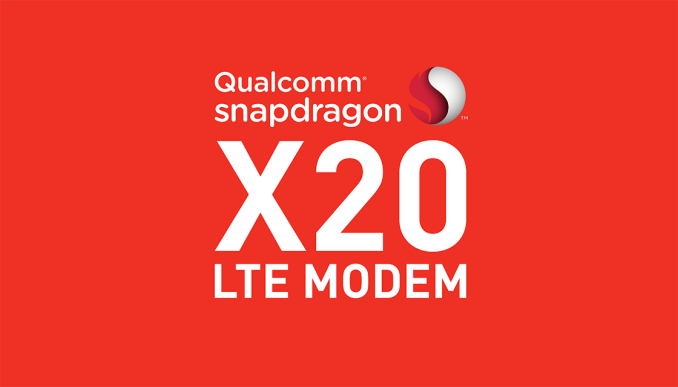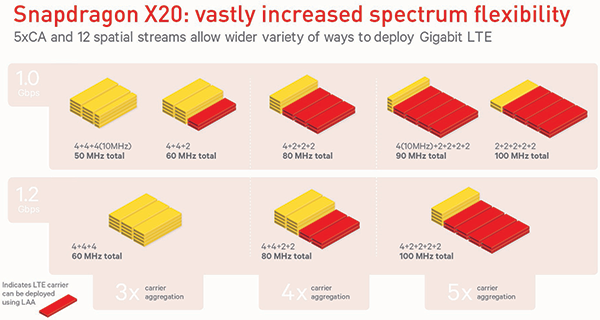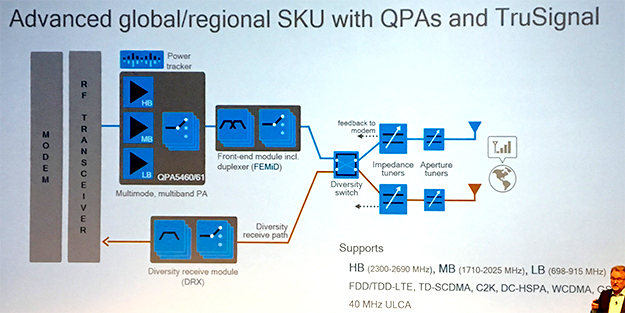Qualcomm Announces Snapdragon X20 LTE Modem & New RF Front-End Modules For Mobile Devices
by Matt Humrick on February 21, 2017 7:30 AM EST- Posted in
- Smartphones
- Snapdragon
- Qualcomm
- LTE
- Mobile
- RF360

Qualcomm announced its first LTE Advanced Pro modem, the X16 LTE, last February, supporting downlink speeds of up to 1.0 Gbps. Today the company announced its second-generation gigabit class LTE modem, the Snapdragon X20 LTE, along with some new RF front-end components.
The Snapdragon X20 LTE modem will use Samsung’s latest 10nm LPE process and offer a few key enhancements over the X16 LTE modem integrated into the Snapdragon 835 SoC. First, the X20 gains support for 5x carrier aggregation (5x20MHz), allowing for more flexible use of available licensed and unlicensed spectrum with over 1000 possible carrier aggregation band combinations. It also increases the number of usable spatial streams from 10 to 12 by performing 4x4 MIMO on three aggregated carriers. These improvements allow the X20 to support UE Category 18 on the downlink, boosting peak theoretical bandwidth to 1.2 Gbps, a 20% improvement over the X16 LTE modem. Uplink bandwidth remains the same, however, supporting up to 150 Mbps with 2x20MHz carrier aggregation and 64-QAM.
Improving performance was not Qualcomm’s primary goal for X20, though; by supporting 5x carrier aggregation (CA) and Licensed Assisted Access (LAA), an LTE Advanced Pro feature that allows CA of licensed and unlicensed spectrum (5 GHz) on the downlink, the X20 allows network operators to deploy gigabit LTE service with only 10MHz of licensed spectrum. This is vitally important in many crowded markets where 20MHz blocks are rare. According to a Strategy Analytics study, 64% of network operators around the globe can deploy gigabit LTE using 20MHz CA and LAA, the configuration offered by the Snapdragon X16 LTE modem. This number increases to 90% when using 10MHz CA and LAA, making gigabit LTE a viable bridge to 5G.
| Qualcomm Snapdragon 4G LTE Modems (High-End) | |||
| Modem | Snapdragon X20 LTE | Snapdragon X16 LTE | Snapdragon X12 LTE |
| SoC Discrete |
N/A yes |
Snapdragon 835 yes |
Snapdragon 820/821 yes |
| UE Category | Cat 18 DL Cat 13 UL |
Cat 16 DL Cat 13 UL |
Cat 12 DL Cat 13 UL |
| Peak Bandwidth | 1.2 Gbps DL 150 Mbps UL |
1.0 Gbps DL 150 Mbps UL |
600 Mbps DL 150 Mbps UL |
| CA Config | 5 x 20MHz DL 2 x 20MHz UL |
4 x 20MHz DL 2 x 20MHz UL |
3 x 20MHz DL 2 x 20MHz UL |
| MIMO | 4x4 (3 CA) | 4x4 (2 CA) + 2x2 (1 CA) | 4x4 (1 CA) |
| Max Spatial Streams | 12 | 10 | 6 |
| Modulation | 256-QAM DL 64-QAM UL |
||
| Cellular Technologies | LTE FDD / LTE TDD / LTE-U / WCDMA / TD-SCDMA / CDMA / GSM | ||
| Additional Features | LAA, CBRS, VoLTE, EVS, Wi-Fi calling, Dual SIM Dual Standby, Dual SIM Dual Active, Dual SIM Dual VoLTE | LAA, CBRS, VoLTE, EVS, Wi-Fi calling, Dual SIM Dual Standby, Dual SIM Dual Active | VoLTE, EVS, Wi-Fi calling, Dual SIM Dual Standby |
| Mfc. Process | 10nm LPE | 10nm LPE / 14nm LPP | 14nm LPP |
The Snapdragon X20 and X16 LTE modems share several features, including LTE Broadcast and Ultra HD Voice quality using the EVS codec. Both modems also support Citizens Broadband Radio Service (CBRS) in the US, a 150MHz slice of shared spectrum in the 3.5GHz band that can be used by operators for gigabit LTE service or even private LTE networks for industrial or large-campus applications.
One new feature exclusive to the X20 is Dual SIM Dual VoLTE (DSDV), a technology that will help carriers transition away from legacy GSM networks. With DSDV the second SIM is no longer limited to 2G or 3G voice duties, because voice can be carried over LTE. It also allows the user to select either SIM for LTE data service.
Like previous Qualcomm LTE modems, the Snapdragon X20 will be offered as a stand-alone product initially, but will likely be integrated into a high-end Snapdragon SoC next year. Qualcomm has begun sampling the new modem to customers and expects the first commercial devices to appear in the first half of 2018.
New RF Front-End (RFFE) Components
Qualcomm also added several new products to its RF360 portfolio, including several new power amplifier modules and its next-generation TruSignal solution. The new components promise to reduce power consumption and improve signal quality, leading to better battery life and more consistent cellular performance under a broad range of conditions. They also adhere to Qualcomm’s philosophy of creating highly integrated RFFE components that reduce part count and simplify RF design for OEMs.
The four new multimode, multiband power amplifier (MMPA) modules—QPA5460, QPA5461, QPA4360, QPA4361—are the first from Qualcomm to use GaAs as opposed to CMOS, which brings certain advantages when working with higher frequencies. The primary difference between the QPA54xx parts and the QPA43xx parts is that the former uses envelope-tracking when paired with a QET4100 envelope tracker IC and provides better power efficiency for LTE TDD networks, while the latter is optimized for average power tracking. All four MMPA modules combine switches with low, mid, and high band power amplifiers into a tightly integrated package.
Qualcomm also released the D5328 Integrated Front-End Module (FEMiD) and D5285 Diversity Receive Module (DRX), both of which increase RFFE integration. The D5328 FEMiD combines layer-transfer switches, certain filters, duplexers, and a quadplexer into a single module, while the D5285 DRX is a similar part for the diversity receive path.
Qualcomm’s latest TruSignal adaptive antenna tuning solution, which combines the QAT3550 impedance tuner, QAT3514 aperture tuner, and QAT3522 antenna diversity switch, is the first to support carrier aggregation. The components work together with the modem, which provides advanced signal processing, in a closed-loop system to ensure optimal signal quality. The third-generation QAT3550 is 30% smaller than the second-generation QFE2550 impedance tuner, and all three QAT35xx parts can be used in conjunction with the Snapdragon 835 SoC.













17 Comments
View All Comments
Eden-K121D - Tuesday, February 21, 2017 - link
If only Networks supported this.A5 - Tuesday, February 21, 2017 - link
The chips have always come first for RF stuff.leexgx - Tuesday, February 21, 2017 - link
if only mobile phones supported this :)this is years away from mainstream by then we have 5G (or whatever USA wants to rename it to as i would not be surprised if they call LTE 5G soon when they get LTE-A)
name99 - Tuesday, February 21, 2017 - link
If only people stopped recycling the same pointless whining from 2007...What exactly are YOUR alternatives, Eden-K121D and leexgx? Nothing changes for ten years then, at the stroke of midnight, the entire cellular infrastructure changes to a new spec and we all have to buy new phones simultaneously on that day?
Eden-K121D - Wednesday, February 22, 2017 - link
I mean there should be an understanding between network infrastructure providers and network companies i.e some sort of synchronizationDanNeely - Wednesday, February 22, 2017 - link
Mis-matched incrementalism is more or less inevitable IMO due to the fragmented and decentralized nature of the market. Different carriers have different amounts of spectrum (both number of blocks and sizes of the blocks) and different willingness to spend on upgrading their infrastructure (eg VZW and ATT doing much larger LTE deployments early vs Sprint and TMobile's more limited rollouts when the hardware was newest and most expensive). You have the same factors on the consumer end, with light/budget users just wanting something that's cheap and works vs hardcore/heavy spending users wanting the absolute best and most capable device at any price.leexgx - Thursday, February 23, 2017 - link
"entire cellular infrastructure changes to a new spec" thats norm what happens like with 4G (real 4G for USA folk witch be LTE or 4G+ LTE-A)it's nice that these new mobile chips are here just most network are not going to upgrade to use it until a new network technology comes out (most are setup for 150-300mb 4G spec) unless a specific location warranties the cost to do it,, like spots where there are very high amount of people in one spot still there phones need to support it to use it (like iphone 6 or samsung S7)
it be nice 5 years down the line though when it filters down into lower spec phones (or the high spec phones are cheap 2-3 years later)
extide - Monday, May 15, 2017 - link
There are advantages for everyone for the carriers to deploy the new tech -- if you can support 5x CA on the back end and then have phones out there striping their downloads across 5 channels that puts less load on each channel, so older phones that can support only less channels will actually see an improvement.iwod - Tuesday, February 21, 2017 - link
This is insane, the RF Front End is so much better then the previous generation. And X20 provides everything there is, I am not sure what's left to implement until 3GPP Rel 14 get released, which is All the Pre 5G work comes in.And how is Intel going to catch up, it doesn't even have an chip to complete against X16. And X12 is better then what intel "will be" offering but on the market already.
And their own 14nm Fabed modem aren't schedule to arrive until 2018.
SydneyBlue120d - Tuesday, February 21, 2017 - link
Intel will show the XMM7560 in a couple of hours, their first 14nm, let's see if they can give it to Apple in time for the iPhone 8 or if it will be a 2018 product. Anyway, Qualcomm continues to be the leading edge and I doubt Intel will ever be able to catch them.